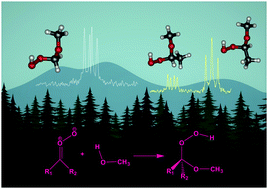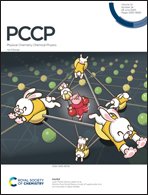Probing Criegee intermediate reactions with methanol by FTMW spectroscopy†
Abstract
Criegee intermediates (CIs) are carbonyl oxides generated from ozonolysis of unsaturated hydrocarbons in the atmosphere. The relatively long lifetime of CIs makes possible the bimolecular reactions with other atmospheric agents. These reactions can potentially be fast enough to contribute significantly to the tropospheric budgets of those species or to alter the rate of generation of secondary organic aerosols (SOAs). In particular, the new adducts formed in these reactions contribute SOA formation because they have larger molecular weights and lower vapor pressures than the reactants and are more condensable. α-alkoxyalkyl hydroperoxides are the nascent products derived from the insertion reactions of CIs with alcohols. In this work we report the direct detection of methoxymethyl hydroperoxide (HOOCH2OCH3, MMHP) and methoxyethyl hydroperoxide (HOOC(CH3)HOCH3, MEHP) as the reaction products between the CIs, CH2OO and CH3CHOO and methanol. High resolution Fourier transform microwave spectroscopy has been used to identify one and two conformers of MMHP and MEHP, respectively. The pre-reactive complex CH2OO–CH3OH was not observed in this experiment, which indicates that CH2OO shows a different reactivity toward methanol than that toward water. Our results for CH3CHOO + CH3OH show that MEHP is produced in similar ratios when syn- and anti-CH3CHOO react with methanol vapor.



 Please wait while we load your content...
Please wait while we load your content...